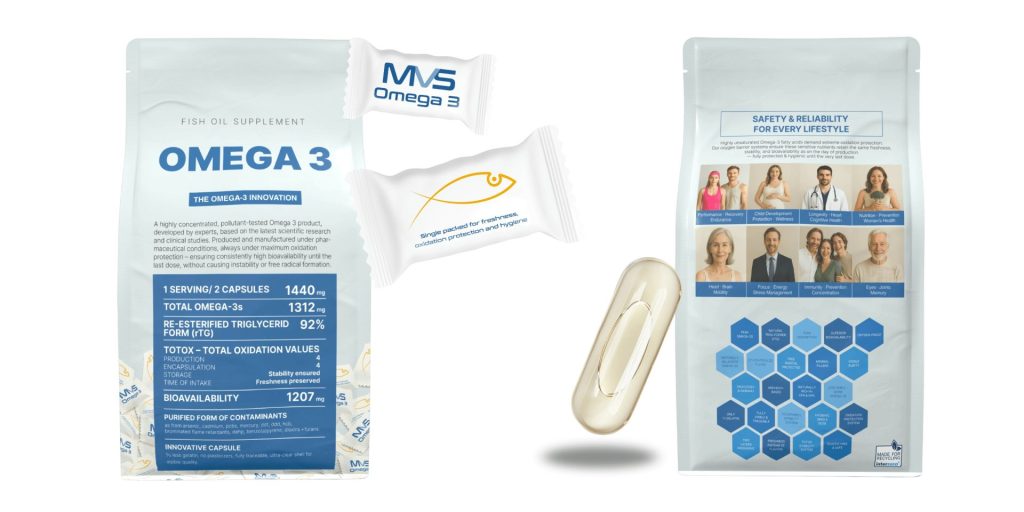Table of Contents
The Rise of Omega-3 as a Lifelong Health Essential
Over the past 30 years, few nutrients have gained as much scientific support as Omega-3 fatty acids. Known as “essential fats,” Omega-3s are foundational for the heart, brain, eyes, immune system, and more. Yet despite their importance, most people still fail to meet the recommended intake.
In 2025, Omega-3s are no longer just a “heart supplement” — research now ties them to mental health, pregnancy, inflammation control, and healthy aging. However, confusion persists: Which Omega-3s are best? How much do you need? What about oxidation and contaminants?
This guide explores the updated, evidence-backed benefits of Omega-3 fatty acids and explains how to choose supplements that truly deliver results.
Omega-3s’ Potential Health Benefits in People
Omega-3 fatty acids, comprising alpha-linolenic acid (ALA), eicosapentaenoic acid (EPA), and docosahexaenoic acid (DHA), have demonstrated a spectrum of health benefits rooted in robust scientific inquiry. ALA, primarily derived from plant sources, serves as a precursor for EPA and DHA, which are prominently found in marine oils. The following list is composed of potential health benefits of Omega-3 fatty acids:
- Cardiovascular health
- Triglycerides: Prescription-grade omega-3 (4 g/day EPA+DHA) lowers triglycerides by ~30% in severe hypertriglyceridemia; lower doses still reduce TGs, though effect sizes are smaller.
- Events & mortality: Recent syntheses suggest modest risk reductions for MI and CV death with omega-3s overall, with stronger signals when EPA is used alone rather than EPA+DHA blends; benefits persist even on background statins.
- Not all meta-analyses agree on mortality endpoints in mixed EPA+DHA trials; heterogeneity (formulation, dose, baseline risk) matters.
- How to Omega-3 for Promoting Cardiovascular Health: For lipid management, dose and formulation matter (see “Choosing a Supplement”). Consider higher doses for triglyceride lowering under clinician guidance, and EPA-focused regimens in high-risk patients.
- Brain & cognitive function
- Mechanisms: DHA is the dominant structural PUFA in neural membranes; EPA modulates neuroinflammation and cerebrovascular tone.
- Latest evidence (2024-2025):
- Adults/aging: Recent meta-analyses (through Dec 2024) show dose-responsive cognitive benefits with omega-3, particularly on attention, processing speed, and global composite scores—greater with ≥1–2 g/day and longer durations.
- Alzheimer’s spectrum: Trials and reviews indicate slower decline on clinical scales in some AD populations, especially when started earlier and with adequate DHA exposure. Results are not universally positive, but the trend is favorable.
- Takeaway: For cognitive aging, prioritize sustained intake (≥6–12 months) with meaningful DHA content (often 500–1000 mg DHA/day), optionally paired with EPA for neuroinflammation.
- Mental health (depression, anxiety, ADHD)
- Major depressive disorder (MDD): Multiple meta-analyses show clinically meaningful reductions in depressive symptoms with high-EPA formulations (≥60% EPA, ~1 g/day range). DHA-dominant products have not consistently shown the same effect in MDD. 2024 RCTs continue to support symptom improvement and safety as adjuncts to standard therapy.
- Anxiety & ADHD: Signal for anxiolytic benefit and ADHD symptom improvement exists (especially with EPA-rich oils), though heterogeneity remains.
- Clinical tip: When the target is mood, choose EPA-rich (>60% EPA) at ~1–2 g/day; monitor for GI tolerance and interactions with anticoagulants.
- Inflammation & immunity (SPMs, autoimmune disease, joints)
- Resolution biology: EPA/DHA are precursors to specialized pro-resolving mediators (SPMs)—resolvins, protectins, maresins—that actively turn off inflammation, enhance clearance of debris, and promote tissue repair (distinct from simple anti-inflammatory suppression).
- Autoimmunity & arthritis: Rheumatoid arthritis: 18 RCTs (n≈1,018) show omega-3s reduce triglycerides and tender joint count, and improve omega-6:omega-3 balance; CRP/ESR changes are smaller and sometimes NS. Osteoarthritis: Recent meta-analysis of RCTs shows reduced pain and better function vs. placebo; mechanistically, down-regulation of inflammatory cytokines and catabolic enzymes is implicated.
- Clinical tip: For inflammatory joint complaints, ≥2–3 g/day EPA+DHA (with food) for at least 3 months is typical in trials; consider SPM-enriched marine oils emerging in research.
- Pregnancy, lactation & early development
- Why it matters: DHA accrues rapidly in the fetal brain and retina in the 3rd trimester; maternal status predicts neonatal stores.
- Updated guidance & outcomes: Strong consensus recommends additional DHA of 100–200 mg/day (beyond baseline intake), often totaling 200–300 mg DHA/day in pregnancy and lactation. Evidence links adequate omega-3 with lower risk of preterm birth, improved infant visual/cognitive outcomes, and healthier inflammatory tone during gestation.
- Practical: Choose purified fish or algae DHA with proven contaminant control; consistent daily intake matters more than sporadic high doses.
- Eye health (dry eye disease & macular degeneration)
Dry eye disease (DED): Multiple 2023–2024 systematic reviews and RCTs report improvement in symptoms and some tear metrics with sustained omega-3 use; responses vary by baseline omega-3 index, EPA content, dose, and duration. rTG omega-3 formulations are being specifically evaluated in DED populations, reflecting growing interest in bioavailability for ocular outcomes.
Age-related macular degeneration (AMD): Observational & MR data suggest higher omega-3 status—especially DHA—is associated with lower AMD risk, with the strongest signals for early/advanced risk reduction; AREDS2 didn’t show prevention for late wet AMD with supplementation alone, so expectations should be realistic.
Takeaway: For ocular surface symptoms, consider EPA-forward blends over ≥3 months; for AMD risk, prioritize dietary pattern + DHA sufficiency rather than “cure” claims.
- Metabolism, body composition & “inflammaging”
By generating SPMs and altering membrane lipid mediators, omega-3s may counter chronic low-grade inflammation (inflammaging), supporting vascular and musculoskeletal health across the lifespan. Omega-3s can modulate PPAR signaling, shifting lipid oxidation and potentially supporting fat mass reduction and resting metabolic rate over ≥6 weeks in some studies; effects are modest and synergize with diet/exercise.
Practical dosing notes (tying benefits to regimens)
- General wellness/prevention: 250–500 mg/day EPA+DHA (diet + supplement). Adjust upward if the diet is low in fish.
- Triglyceride lowering: 2–4 g/day EPA+DHA, ideally prescription-grade under medical care.
- Mood (MDD): 1–2 g/day total omega-3 with ≥60% EPA.
- Inflammatory joints (RA/OA): target ≥2–3 g/day EPA+DHA for ≥3 months.
- Pregnancy/Lactation: 200–300 mg DHA/day (algae or purified fish).
- Dry eye: EPA-rich formulations trialed across 3–6 months; consider rTG form for absorption.
Sources of Omega-3
- Fatty Fish:
- Salmon: Salmon is one of the richest sources of Omega-3s, particularly DHA and EPA. Wild-caught salmon generally contains higher levels of Omega-3s compared to farm-raised varieties.
- Mackerel: Mackerel is another fatty fish high in both EPA and DHA. It’s a flavorful fish commonly enjoyed grilled, smoked, or pickled.
- Sardines: Sardines are rich in Omega-3s and also provide a good amount of calcium due to their edible bones. They are available canned in water, oil, or sauces.
- Trout: Rainbow trout and other varieties of trout are good sources of Omega-3s. They are often available fresh or smoked.
- Herring: Herring is a fatty fish that can be enjoyed fresh, smoked, or pickled. It is rich in both EPA and DHA.
- Anchovies: Anchovies are small fish that pack a punch in terms of flavor and Omega-3 content. They are often used in sauces or as toppings.
- Tuna: While tuna is a source of Omega-3s, the content can vary based on the type of tuna. Albacore (white) tuna generally contains more Omega-3s than light tuna.

For individuals who may not consume fish regularly or have dietary restrictions, Omega-3 supplements such as fish oil capsules or algal oil capsules (derived from algae) are available. These can provide a convenient alternative to meet Omega-3 needs, but it’s essential to choose high-quality supplements and consult with a healthcare professional for personalized advice on dosage.
- Flaxseed and Flaxseed Oil: Alpha-Linolenic Acid (ALA): Flaxseed, renowned for its ALA content, serves as a plant-based source of omega-3 fatty acids.
- Chia Seeds: ALA Content: Chia seeds are a plant-based powerhouse, providing a notable source of ALA omega-3 fatty acids.
- Walnuts: ALA Enrichment: Walnuts offer a plant-based source of ALA, contributing to omega-3 intake in vegetarian diets.
- Canola Oil: ALA Concentration: Canola oil stands as a culinary source of ALA, promoting the incorporation of omega-3s into everyday cooking.
- Soybeans and Soy Products: ALA Content: Soybeans and soy-derived products contribute to omega-3 intake, especially for individuals following vegetarian or vegan diets.
- Eggs, especially Omega-3 Enriched: DHA and EPA Enrichment: Eggs from hens fed omega-3-rich diets, including fish oils, provide a source of DHA and EPA.
- Krill Oil: EPA and DHA Source: Krill oil, derived from tiny crustaceans, serves as a supplement rich in both EPA and DHA.
- Algal Oil: Plant-Based DHA: Algal oil, sourced from algae, offers a plant-based alternative for obtaining DHA, particularly suitable for vegetarian and vegan lifestyles.
Omega-3 sources in Supplements
| Algae Oil | Not as much tested as Fish oil |
| Krill Oil | Not as much tested as Fish oil |
| Cod Liver | must be transferred first into ALA. The Absorption rate is very low |
| Vegetable Oils | must be transferred first into ALA. The Absorption rate is very low |
| Fish Oil Ethylester Form (EE) | Read all about it here. |
| Fish Oil Triglyceride Form (TG) | Read all about it here. |
Food Sources vs Supplements
Best Food Sources
- Fatty fish: sardines, anchovies, mackerel, salmon.
- Algae oil: the only plant-based source of DHA.
- Nuts and seeds: ALA only (poorly converted).
Why Supplements Are Often Necessary
- Low fish consumption worldwide.
- Concerns over contaminants (mercury, PCBs, microplastics).
- High demands during pregnancy, aging, or chronic illness.
- Inefficient conversion of ALA to EPA/DHA.
How to Choose the Right Omega-3 Supplement
- Purity & Safety → Certified free of heavy metals, PCBs, microplastics.
- Freshness → Low TOTOX value (ideally <5).
- Bioavailability → Prefer rTG or phospholipid forms over EE.
- Sustainability → Small fish (anchovies, sardines) or algae oil.
- Packaging → Protection against light, heat, and oxygen.
MVS Omega-3 — Setting a New Standard in Purity, Stability, and Bioavailability
Developed by MVS Pharma’s medical and pharmaceutical experts, MVS Omega-3 represents a new generation of scientifically designed Omega-3 supplements. With a 92% natural rTG structure, verified bioavailability of 1207 mg, and our proprietary T-TOX™ oxidation control system, it ensures exceptional purity, stability, and absorption. Each batch meets European Pharmacopeia standards and is tested for over 20 potential contaminants — setting a benchmark for transparency and trust in modern nutritional science.

Not all Omega-3 supplements are created equal. The more unsaturated and effective Omega-3 molecules become, the more sensitive they are to air exposure — making oxidation protection the single most critical factor for preserving both safety and bioavailability. Once oxidation begins, oil turns rancid, loses efficacy, and may even generate free radicals.
At MVS Pharma, this challenge defined our mission. We engineered MVS Omega-3 as a next-generation formulation designed for uncompromised purity, verified stability, and maximum biological usability.
Key Facts:
- Pharma-Standard Purification & Testing — each batch is verified to meet European Pharmacopeia standards and is screened for over 20 contaminants, including heavy metals, PCBs, dioxins, PAHs, and plasticizers.
- 90% Purified Omega-3 Concentration — delivering 1440 mg total oil with 1312 mg active Omega-3s (EPA 784 mg, DHA 518 mg) per serving.
- 92% Re-esterified Triglyceride (rTG) Form — structurally identical to natural fish oil for superior absorption (1207 mg bioavailable) and full physiological compatibility.
- T-TOX™ Total Oxidation Control System — exclusive German oxidation-management technology ensuring freshness and molecular integrity from production to the last capsule.
- Innovative Double Packaging — Individually Sealed Protection. Each capsule is individually sealed in an oxygen-free, double-wrapped container filled with argon gas. This advanced protective solution shields the sensitive Omega-3 oil from oxidation, light, and moisture — preserving the purity, stability, and freshness of each capsule until the very last dose.
- Ultra Thin Capsule Release 3.0™ — 2/3 less gelatin, no plasticizers, and >91% active ingredient load for transparency, purity, and optimized payload.
- Natural Tocopherol Matrix (α, β, γ, δ) — balanced antioxidant system calibrated to protect high-purity oil without destabilization.
The result is an ultra-pure, oxidation-protected Omega-3 supplement that maintains its natural structure, freshness, and full efficacy until the final dose — ensuring consistent support for cardiovascular, cognitive, visual, and immune health.
Summary: Omega-3s as a 2025 Health Investment
In 2025, Omega-3 fatty acids are recognized not only for heart health but also for brain function, mental resilience, pregnancy, inflammation control, and healthy aging. Yet with widespread deficiency and quality issues in the supplement market, choosing the right product matters more than ever.
The solution: clean sourcing, advanced oxidation protection, and bioavailable forms like rTG Omega-3. These innovations, combined with sustainable practices, represent the gold standard for modern supplementation — and MVS Pharma is leading the way.
Disclaimer: As a service to our readers, MVS Pharma GmbH publishing provides access to our library of archived content – in our blog. Please note the date of last review or update on all articles. No content on this site, should ever be used as a substitute for direct medical advice from your doctor or other qualified clinician.
FAQs
-
What are the main health benefits of Omega-3 fatty acids?
They support cardiovascular, cognitive, mental, and immune health; aid pregnancy and child development; and reduce chronic inflammation.
-
How much Omega-3 should I take daily?
Adults need 250–500 mg/day EPA+DHA. High-risk groups may need ≥1000 mg/day. Always consult a health professional on this matter.
-
What’s the difference between EPA and DHA?
EPA reduces inflammation and protects the heart. DHA supports brain function, mood, and vision.
-
Can plant sources alone meet my Omega-3 needs?
No. ALA from plants converts poorly into EPA/DHA. Direct EPA/DHA from fish or algae is needed.
-
Why does the form of an omega-3 supplement matter?
rTG forms are absorbed better than ethyl esters, making them more effective.
-
How can I tell if my fish oil is rancid?
A strong fishy smell or aftertaste often signals oxidation. High-quality oils are virtually odorless.
-
Are Omega-3s safe in pregnancy?
Yes. DHA is especially crucial for fetal brain and eye development.
-
Can Omega-3s improve depression or ADHD?
It is highly likely that for most people, high-EPA formulations will have benefits for major depressive disorder and ADHD in children.
-
What is TOTOX in Omega-3 supplements?
It measures oxidation. Lower values indicate fresher, safer oil.
-
What makes MVS Omega-3 different?
It offers oxidation resistance, superior absorption in rTG form, full safety testing, and double protection packaging — ensuring purity and potency from production to consumption.
Sources:
- National Library of Medicine – “Role of omega-3 fatty acids in the prevention and treatment of cardiovascular Diseases: A consensus statement from the Experts’ Committee of the National Society of Cardiometabolic Medicine”
- National Library of Medicine – “Effects of Omega-3 Fatty Acids on Immune Cells”
- National Library of Medicine – “Beneficial Outcomes of Omega-6 and Omega-3 Polyunsaturated Fatty Acids on Human Health: An Update for 2021”
- MED Park hospital article – “OMEGA 3 – Health Benefits of Nutrition”
- Harvard T.H. Chan School of Public Health – “Omega-3 Fatty Acids: An Essential Contribution”
- Cleveland Clinic article – “Omega-3 Fatty Acids”
- Science Direct – “Omega-3 long-chain polyunsaturated fatty acids: Metabolism and health implications”


